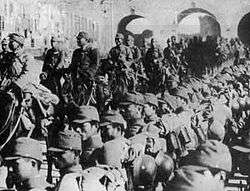Shanghai Expeditionary Army
| Shanghai Expeditionary Army | |
|---|---|
 Japanese troops enter Nanjing | |
| Active | 1932, 1937-1938 |
| Country | Empire of Japan |
| Branch | Imperial Japanese Army |
| Type | Infantry |
| Role | Corps |
| Garrison/HQ | Nanjing |
| Engagements | Battle of Shanghai, Battle of Nanjing |
The Shanghai Expeditionary Army (上海派遣軍 Shanhai-haken-gun) was a corps-level ad hoc Japanese army in the Second Sino-Japanese War.
The Shanghai Expeditionary Army was first raised on February 25, 1932 as a reinforcement for Japanese forces involved during the First Battle of Shanghai. It was dissolved in June 1932, after the conclusion of that incident.
The Shanghai Expeditionary Army was raised a second time on August 15, 1937 on the eruption of full scale hostilities between the Empire of Japan and the Republic of China. Its forces participated in the Second Battle of Shanghai, and the subsequent drive inland to the Battle of Nanking. Troops from this army were also involved in the subsequent Nanjing Massacre.
The Shanghai Expeditionary Army was disbanded on February 1, 1938, and its component units were incorporated into the Japanese Central China Area Army.
Organization 1932
Organization 1937-1938
List of commanders
Commanding officer
| Name | From | To | |
|---|---|---|---|
| 1 | General Yoshinori Shirakawa | 25 February 1932 | 29 April 1932 |
| X | Disbanded | ||
| 2 | General Iwane Matsui | 15 August 1937 | 2 December 1937 |
| 3 | Lieutenant General Prince Asaka Yasuhiko | 2 December 1937 | 14 February 1938 |
Chief of Staff
| Name | From | To | |
|---|---|---|---|
| 1 | Lieutenant General Kanichiro Tashiro | 25 February 1932 | 29 April 1932 |
| X | Disbanded | ||
| 2 | Lieutenant General Mamoru Iinuma | 15 August 1937 | 14 February 1938 |
References
- Dorn, Frank (1974). The Sino-Japanese War, 1937-41: From Marco Polo Bridge to Pearl Harbor. MacMillan. ISBN 0-02-532200-1.
- Madej, Victor (1981). Japanese Armed Forces Order of Battle, 1937-1945. Game Publishing Company. ASIN: B000L4CYWW.
External links
- Wendel, Marcus. "Axis History Factbook". Shanghai Expeditionary Army.